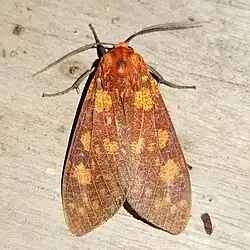Mazaeras
| Mazaeras | |
|---|---|

| |
| Scientific classification | |
| Kingdom: | Animalia |
| Phylum: | Arthropoda |
| Class: | Insecta |
| Order: | Lepidoptera |
| Superfamily: | Noctuoidea |
| Family: | Erebidae |
| Subfamily: | Arctiinae |
| Subtribe: | Phaegopterina |
| Genus: | Walker, 1855 |
is a genus of moths in the family Erebidae. The genus was first established by Francis Walker in 1855.[1]. Mazaeras moths are part of the subfamily arctiine tussock moths, which are recognized for their diversity and often vibrant coloration.
Taxonomic Classification
- Kingdom: Animalia
- Phylum: Arthropoda
- Class: Insecta
- Order: Lepidoptera
- Family: Erebidae
- Subfamily: Arctiinae
- Tribe: Arctiini
- Genus: Mazaeras
- Species: Mazaeras francki [1] [2]
Taxonomic Significance
Mazaeras is a representative genus of the arctiine moths—a group known for its diversity and for playing ecological roles in Neotropical countries. [3]
Notable Species
Several species are classified within the genus Mazaeras. Some of the recognized ones include:
- Mazaeras conferta (Walker, 1855) - Found in Espírito Santo, Brazil [4]
- Mazaeras francki (Schaus, 1896) - Found in Brazil [5]
- Mazaeras janeira (Schaus, 1892)
- Mazaeras macasia (Schaus, 1924)
- Mazaeras magnifica (Rothschild, 1909)
- Mazaeras mediofasciata (Joicey & Talbot, 1916) - Recorded in Peru
- Mazaeras melanopyga (Walker, 1869)
- Mazaeras soteria (Druce, 1900)
Distribution and Ecology
Species within Mazaeras are found in South America, particularly in Brazil and Peru. Their habitats and ecological roles vary by species, but like many arctiine moths, they are thought to play a part in local food webs as both pollinators and as prey species. [6]
Research and Recent Developments
Ongoing taxonomic work continues to clarify species boundaries and descriptions within Mazaeras, and new species continue to be described as recently as the 21st century. [7]
References
- ^ Savela, Markku. "Mazaeras Walker, 1855". Lepidoptera and Some Other Life Forms. Retrieved September 22, 2019.
External links
- Pitkin, Brian & Jenkins, Paul. "Search results Family: Arctiidae". Butterflies and Moths of the World. Natural History Museum, London.